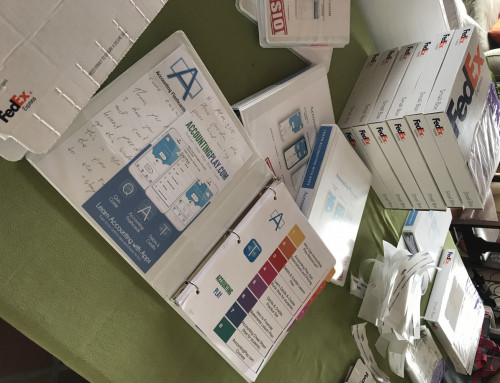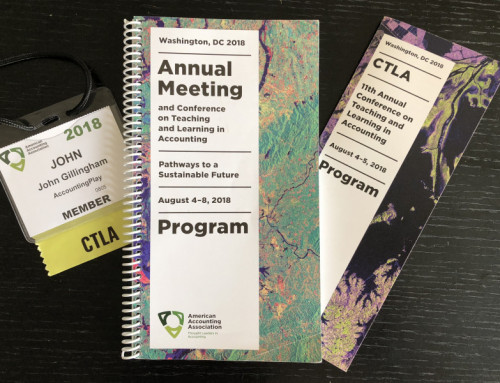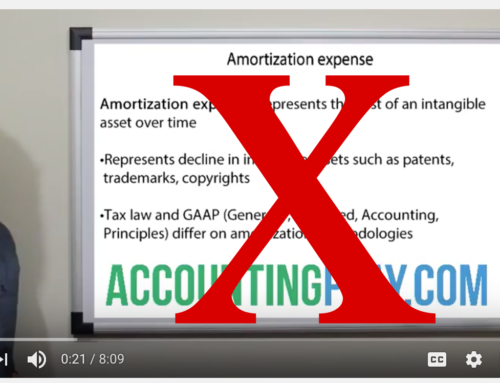The American Accounting Association’s (AAA) Conference on Teaching and Learning in Accounting (CTLA) focuses on Accounting Pedagogy in the academic environment. It features a weekend of sessions prior to the main event and also appears in the main conference. It is organized around keynote speakers, panels, poster-sessions, and round-tables that explore teaching strategy. Major themes include student engagement, data driven testing to improve classroom results, creative ways to teach, and use of technology. I diligently attend these sections to understand teacher needs and how Accounting Play can continually improve as free apps, immediately useful for principle lessons. This is just one example of the many sections within the AAA that allow members to pursue their passions within the profession.
The technologization of the accounting classroom is an inevitability at this point. Some teachers have resisted this change, but others have leaned into it and harnessed the power of technology to make their lives easier and enrich their curriculum. Below are some of my favorite examples of instructors using technology in the classroom that came up at this year’s CTLA meeting.
Teacher Learning Toolbox - Markus Ahrens & Cathy Scott
Accounting Teaching Tools - Veronica Paz
I very much enjoyed what I could attend and comprehend during the CTLA marathon week. I am also pleased by the deep commitment of teachers taking the time to attend conferences year over year. Some leaders also attend multiple conferences, such as TACTYC, which I attended as well. Such AAA leadership and teacher dedication has created a wonderful community and challenging conference to run. CTLA gets my rave review, but, I humbly offer some ideas for improvement below.
While I enjoyed the blistering pace of the weekend, I wonder if there could be benefits to reducing the quantity of presenters down and increasing the depth of discussion and time spent absorbing and applying information. Another idea might be to adopt an optional “mastermind” approach where teachers would be placed in similar small round table groups. In such a setup there is an MC that helps direct teacher conversation, storytelling, and improvement possibilities. The mastermind can also facilitate longer-term connections and dialogue.
One of the speakers actually questioned how much information was actually taken home and applied. It’s easy to understand the impulse to cram as much information into a 1.5-day session once a year and hope that more in-depth discussions occur at the discretion of the attendees. However, how much information is too much to even allow for that? There was some take-home actionable content available, but no central location to access these materials. A central board (physical at first and then digital later) where teachers can find shareable material would be extremely helpful.
To make the best use of everyone’s time, presenters in every format would benefit from having established guidelines to help them prepare their content and presentation. Not only would it provide some continuity in the overall quality of presentations, but it would also improve networking possibilities. Even simple things like requiring business cards, digital flyers, or easy shareable slides would go a long way. Networking is clearly a priority for the conference: to enter the conference raffle, teachers had to meet five other people. With long-term connections on the agenda, taking some additional steps to facilitate easy interaction would be worthwhile.
The CTLA includes a broad group across the board, but such diversity can inhibit attendees’ access to the parts of the conference that are most valuable to them. By further categorizing the weekend’s events and attendees by their main focus--having participants wear tax, audit, or principles ribbons, for example-- combined with the mastermind approach, the 1.5 days could become much more poignant.
The current mechanism for collaborating with like-minded teachers seems to be the picking of sections, so that when a teacher goes to the “how to teach debits and credits with apps section” (just an example) then that person finds their intro to accounting tribe. But like other conferences I have attended there is overload and this inherent issue can be addressed by adjusting some of the variables mentioned above, to facilitate the broad goals of the AAA and this specific event.








Leave A Comment